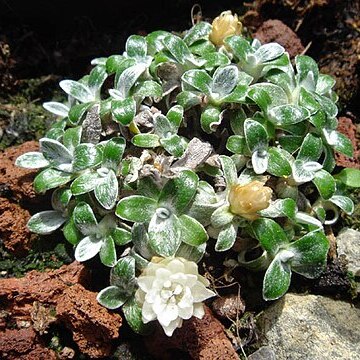Dwarf shrub, up to 100 mm high; cushion-forming, compact, branches densely tufted, leafy. Leaves closely imbricate, rosulate when viewed from above; blade linear to narrowly obovate, 4-15 x 1-5 mm, upper surface with silky, tissue paper-like indumentum, green with silvery sheen, drying silver-grey, lower surface white-felted. Heads discoid, campanulate, 10-15 x ± 25 mm, sessile, solitary at branch tips. Involucral bracts in 8-12 series, graded, closely imbricate, much exceeding florets; outer pale brown, rose-coloured or crimson; inner white or tinged rose, opaque, radiating, stereome divided. Receptacle epaleate, shortly honeycombed. Flowers: disc florets only, 37-118; corolla campanulate above, yellow; Oct. Fruit with cypsela hairy. Pappus of many barbellate bristles, bases cohering lightly by patent cilia.
Cushion-forming, dwarf shrublet, branches densely tufted, leafy. Leaves 4-15 mm long, imbricate, rosulate, linear to lanceolate-elliptic, upper surface with silky, tissue paper-like indumentum, green with silvery sheen, drying silver-grey, lower surface white-felted. Capitula campanulate, 10-15 mm long, sessile, solitary at branch tips; involucral bracts in 8-12 series, graded, outer pale brown, rose or crimson, inner white or tinged rose, opaque. Receptacle ± honeycombed. Flowers 37-118, yellow. Flowering time July-Dec. Pappus of many bristles, bases cohering lightly by patent cilia. Cypselae 2 mm long, elliptic, hairy.

